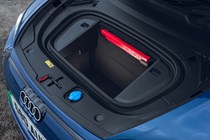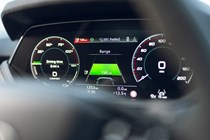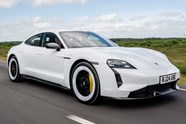Audi E-Tron GT review

At a glance
| Price new | £107,770 - £166,370 |
|---|---|
| Used prices | £31,554 - £96,900 |
| Road tax cost | £620 |
| Insurance group | 50 |
Get an insurance quote with

|
|
| Fuel economy | 2.9 - 3.4 miles/kWh |
| Range | 282 - 375 miles |
| Miles per pound | 4.6 - 10 |
| Number of doors | 4 |
| View full specs for a specific version | |
Available fuel types
Fully electric
Pros & cons
- Facelift brings more power and performance
- New active air suspension is comfortable and controlled
- Faster charging and longer battery range
- Not much room in the rear seats, small boot
- Some cheap-feeling bits inside
- Porsche Taycan uses same tech, offers wider choice
Audi E-Tron GT Saloon rivals
Overview
After just over three years on sale, the Audi E-Tron GT was updated in 2024 to ensure it remains one of the best electric cars. Its striking four-door saloon styling hasn’t been monkeyed with a great deal, with the majority of changes occurring under the skin to boost performance, driving range and charging speeds. There’s even a bonkers 925hp RS E-Tron GT Performance that’ll get from 0-62mph in a brain scrambling 2.5 seconds. You can go even faster in the related Porsche Taycan, but do you really want to?
What’s more, the updated E-Tron GT line-up starts with an S model that has more power than the outgoing RS version. So although this has driven the entry-level asking price into six figures, buyers are getting the very best electric vehicle (EV) tech Audi and Porsche have at their disposal. An assertion supported by longer driving ranges, faster charging and a new active air suspension system that delivers remarkable ride comfort and control.
Since these are updates also received by the Taycan earlier in 2024, there is a slight question of how the two models can really co-exist. Historically the driver-focussed Porsche has massively outsold the comfier Audi, so we could go even further and question why anyone would buy the E-Tron GT when they could have a Taycan instead.
Having tested both over hundreds of miles in Europe and the UK (see our explainer page to discover more about how we test cars), the answer is a combination of subtly different characters and perhaps a preference of style. Audi says that most E-Tron GT customers are initially attracted by the car’s looks.
These have changed for the facelift, but only slightly. The narrower headlights are the most obvious difference, but there are new alloy wheel designs, revised bumpers and, on higher-specification RS Performance variants, the Audi debut of ‘camouflage carbon’ design elements. This is made from chopped up pieces of carbonfibre rather than the neatly weaved type, giving a different visual impression.
There are also updates to the upholstery and steering wheels, as well as a new Variable Light Control roof option that uses ‘smart glass’ with changeable transparency. Although the original entry-level Quattro model has been dropped, all three 2024-onwards versions – S, RS and RS Performance – are now capable of over 300 miles in the real world.
Rivals include the Porsche it’s so closely related to and the long-standing Tesla Model S, although that is now only available in left-hand drive. You could also look at the Mercedes-Benz EQE and its AMG-badged counterpart, though these aren’t anywhere near as dynamic, and there are few electric BMWs to choose from as well. You might also consider the Kia EV6 in high-performance GT form, but that isn’t anywhere near as fast or premium. And if it’s electric performance you’re after, the Hyundai Ioniq 5 N has set a new bar for driver involvement.
Over the next few pages you can find out what we think about the Audi E-Tron GT, with our review covering its practicality, technology and the driving experience, which is the part where we’ll outline why you might want to buy one instead of the equivalent Porsche. Keep reading.















































